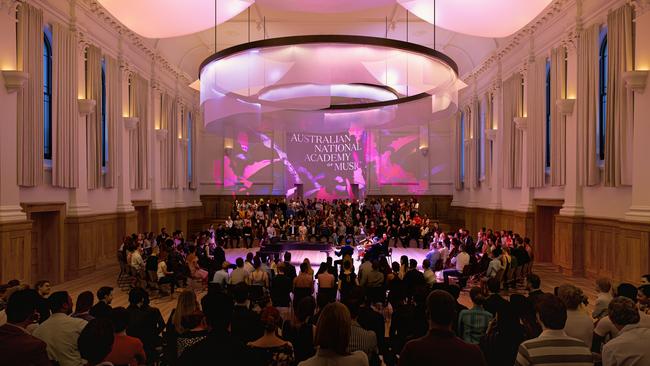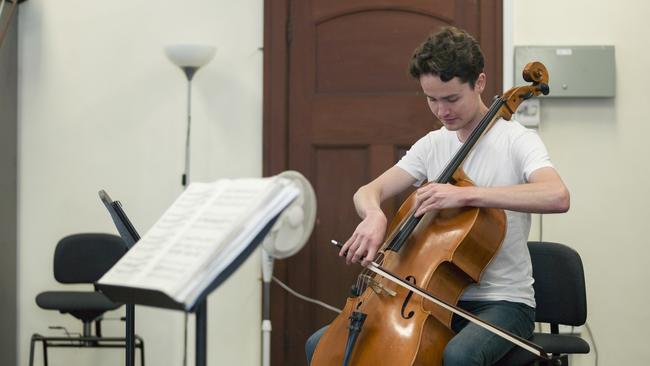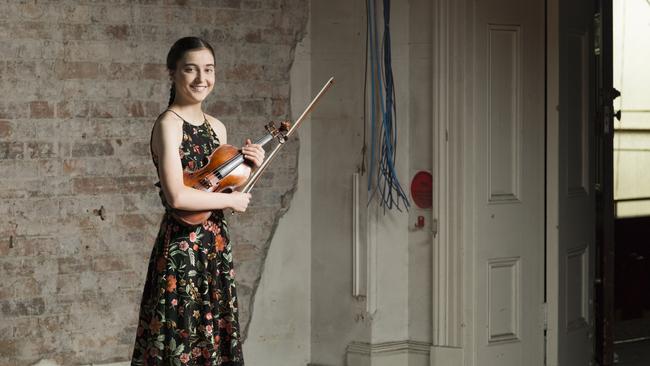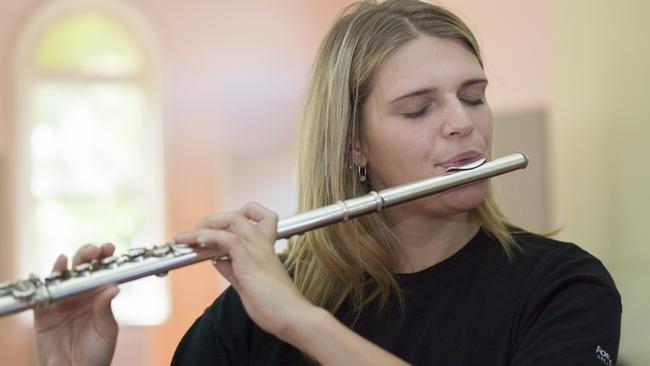The Academy came back from the dead ... now it wants to go home
The Australian National Academy of Music is the top-flight arts institution which offers young musicians training ‘unlike anything in the world’. How could it possibly be homeless?

It’s a glorious March evening when 25 students from the Australian National Academy of Music (ANAM), the nation’s most prestigious classical musician training school, take their places alongside the Sydney Symphony Orchestra for the first performance of the SSO’s production of Gurrelieder, Arnold Schoenberg’s epic medieval tale of love and loss. Gurrelieder tells of the romance between King Woldemar and the young maiden Tove. When Tove is killed at the behest of the vengeful queen, Woldemar curses God and is condemned to a life searching for his beloved, flying through the night sky alongside an army of the undead.
Led by chief conductor Simone Young, it’s a musical landmark. The stage in the Concert Hall of the Sydney Opera House has doubled in size to accommodate a Herculean orchestra of 140 musicians and a chorus of 285. When the chorus joins for the second act, it feels like there are as many people on stage as there are in the audience. Despite the ominous date (it’s the mythical Ides of March), it’s a triumph and the performance commands a standing ovation.
You have to squint to notice Lydia Sawire, aged 25, on violin and Noah Lawrence, 21, on cello – students from ANAM taking part in what is essentially some of the most elite workplace training in the world.
On this same night, Ronan Apcar, a student in his second year at the Academy, is having a very different experience, travelling between Tongala and Numurkah in northern Victoria, performing mini operas in their town halls. “A lot of them told me that they had never seen a concert like it before,” Apcar tells me over sandwiches in the Academy’s kitchen. “One week we could be taking part in collective improvisation or taking a place beside members of the SSO. None of us feels like one is more important than the other. It’s all music making. Their contribution to Australian culture by performing at this unbelievably high standard is probably just as impactful as playing in these towns to a couple of hundred people.”

The Academy is the top-flight arts institution most Australians have never heard of – one of the “Arts8” group of national training institutions for the performing arts, alongside the Australian Ballet School, the National Institute of Dramatic Art and NAISDA Dance College. But the Academy is unique because it does not follow a formal curriculum; students don’t leave ANAM with a degree; instead, they perform in over 180 events each year, leading many to refer to it as a training academy by day and a performing arts company by night.
The training is high pressure and the application process tough – including two audition tapes, a written statement and an interview.
The Academy’s annual grant from the federal government is $3.5 million (a “one-off” uplift for all the Arts8 organisations brought it to $4.1 million this year) and it also raises around $2 million annually from sponsorship and philanthropic support. And yet, perhaps even more than its fellow schools, ANAM has faced an existential battle for survival – what The Australian’s arts pages once described as a series of “near-death experiences”. Gurrelieder’s King Woldemar had his quest and his crew of undead henchmen. The Academy has its own curse, facing down an attempt by Canberra to merge it with the Australian National University seven years after a decision by the federal government to pull funding from the school in 2008. Amid that crisis, Paul Kelly, singer, songwriter and national treasure, was among the luminaries who rushed to its defence. Today, the Academy is once again holding its breath for critical funds.
Since October 2020 the Academy has taken temporary lodgings at the picturesque Abbotsford Convent in inner-city Melbourne while its original home, the South Melbourne Town Hall, awaits a reconstruction.
“ANAM’s great strength is that, along with rigorous traditional training, it also exposes students to collaboration with diverse musicians and composers in and outside the classical world, thereby deepening and widening their experience,” says Kelly, who recorded his live album Conversations With Ghosts alongside ANAM students in 2012.
The program at ANAM is demanding – students receive more than 60 hours of one-on-one training and hundreds of hours of coaching from a roster of visiting international teachers and faculty members who are, themselves, performing musicians. Over the past three decades, the institution has become a feeder school for the major orchestras in Australia. Academy alumni receive major national and international awards and are peppered throughout orchestras and chamber ensembles across the globe, including the Berlin Philharmonic, Mahler Chamber Orchestra and London Philharmonic Orchestra. The Academy also has partnerships with international training academies including the Berlin Philharmonic’s Karajan Academy and London’s Guildhall School of Music and Drama.

For former student Harry Ward, appointed to the First Violins of the Berlin Philharmonic where he is on his probationary term, ANAM gave him the “tools to deal with high pressure environments”. It paved the way for a successful audition with the orchestra.
“It’s like a national music team,” says Finnish pianist Paavali Jumppanen, who has been the Academy’s artistic director for the past four years and is an acclaimed solo recitalist and recording artist; he also co-founded the Väyläfestival – an arts festival that takes place at numerous locations along the shores of the Torne River in northern Scandinavia. “If you think of the athletes who go to the Olympic games, the kind of training they get – that’s what we give our students. There is nothing else like it anywhere in the world.”
Coming from Finland, Jumppanen is often asked about the highly regarded music education system of his native country. “But I was going back to Finland to say, ‘They’re doing something unique in Australia.’”
For Nick Bailey, ANAM’s general manager, the Ides ofMarch has nothing on October 23, a date he and his colleagues refer to as Fax Day. It’s the day the music (almost) stopped. The decision by Peter Garrett in 2008 to shut down the nation’s premier music academy caused outrage before it was quietly reversed. So how exactly did it go down? “A fax arrived from Canberra on the 23rd of October 2008 saying that funding was going to be cut, all staff made redundant, and that ANAM was to be closed down by the end of that year,” Bailey says.
The decree had been made by then Arts Minister Peter Garrett. “We need to make sure that there’s a more effective, better directed way of producing this kind of training for these elite classical musicians. I’m not going back on the decision in any way,” said Garrett at the time.
Bailey, together with internationally renowned composer, conductor and violist Brett Dean, who was then ANAM’s artistic director, started what he describes as a “war campaign”. A petition was signed by over 700 artists, including You Am I’s Tim Rogers, Dame Joan Sutherland, Paul Kelly, JM Coetzee and Richard Tognetti. Talkback radio interviews were lined up (Alan Jones was on board) and the institution’s allies activated.
There were guerilla tactics, too. “I was invited to introduce some ANAM performers at a lunch,” Richard Tognetti says. “And I knew that Julia Gillard, who was Deputy Prime Minister at the time, was attending.” When the students took to the stage Tognetti went rogue. “I said, ‘You need to know that the students behind me are students from the National Academy of Music and the present government is planning to close this extraordinary institution down.’ Everyone was aghast. I spoke for maybe two minutes before the convenor looked at me like, ‘What the hell are you doing?’ and told me that I had to stop.”
Tognetti took his seat which, as luck would have it, was next to Gillard’s. “She was really impressive. She listened and told me that she was fully aware of the issue and that it was under discussion. I don’t know if it had any impact, but there was progress. It was a massive effort by the students at the time, many of whom are now in the profession. Brett Dean was tireless. I just came in from the outside and kicked a few balls around.
“But there was a certain irony, which I will express, that it was a musician who tried to close it down. And that irony wasn’t lost on the likes of Paul Kelly either.”
“I was one voice among many,” Kelly tells me over email (indeed, Kim Williams, then CEO of Foxtel, now ABC chair, was on the Academy’s board at the time of the funding crisis). “In the end the case to keep ANAM going was irresistible.”
The Government backlipped on the decision and Dean and Bailey have raised a glass on Fax Day ever since.
It was cellist and founder of the ACO, John Painter, who responded to Prime Minister Paul Keating’s request to develop a plan for the establishment of a Juilliard-style institution with a hybrid model of a physical home in Canberra, funded by the Commonwealth Government. Painter was readily able to do this, as he had already completed plans for such an institution to be funded more locally in Canberra.
When Keating did give Australia its national music academy it was with his typical brand of chutzpah – he used his bold 1994 Creative Nation Statement to change tack and announced the foundation of ANAM in Melbourne. Keating had plumped up funding for the Sydney Symphony Orchestra but not the Melbourne Symphony Orchestra. Like a baby switched at birth, Keating gave ANAM to Melbourne.
While Painter was extremely disappointed by the direction ANAM took in its formative years, he is now a fierce supporter of the institution. “The Academy vision was, for the first years of its life, used by various artistic directors as a stepping stone to their next appointment, with no realisation of the Academy’s aims and objectives,” Painter, who is now 91, writes over email.
In the years that followed Painter twice recommended that funding be taken away from the Academy and given to Youth Music Australia, “where it could be used constructively by music administrators who were actually interested and experienced in the recognition and nurturing the talents of young Australian musicians.”
It was only once Brett Dean was appointed as artistic director that Painter saw what he describes as “the possibility of ANAM realising some of the aspirations I had for it all those years earlier”.
The 70 or so ANAM students have a rigorous training program acrossthree years. Before the doors open at 8am, the students cluster on the front steps, weighed down by their instruments, eager to get into their rehearsal rooms. The students have even asked staff to keep the school open on the weekends.
“We open up for them in the afternoons only. We also encourage them to rest,” Bailey says.
“The way they support us shows that they understand what we are going through,” says Maria Zhdanovich, who is in her second year studying flute, speaking about the robust health and wellbeing program at ANAM. Like athletes, there are physical injuries elite musicians are prone to – bursitis, carpal tunnel syndrome, tendonitis and others – and mental health challenges that arise from their demanding training program. “A lot of the time it feels like you’re an open nerve ending – you are just so receptive.

Some days it feels like, ‘I know what I’m doing and this is my passion.’ And other days it’s like, ‘Wow, everyone is better than me and I actually don’t know anything.’ These roles can reverse twice in one week.”
Unlike athletes, the students at ANAM do not currently have purpose-built facilities in which to train. In October of 2018 – almost a decade to the day after Fax Day – a structural beam from the roof above the ANAM offices at the South Melbourne Town Hall collapsed across the desks of two staff members. Curse stuff. “It almost took the lives of two of them,” Bailey says. “It was a traumatic event for any organisation to navigate.” The Hogwarts-style Abbotsford Convent has been ANAM’s home for the past four years. And while it’s a picturesque temporary home, it is not fit for purpose.
The silver lining of the 2018 catastrophe has been the ambitious $70 million project to restore the South Melbourne Town Hall. The project, led by architect Peter Elliott, will transform the grand 1879 building into both a purpose-built training academy and a performing arts precinct. The 350-seat main hall will be updated with the infrastructure it always lacked – heating, cooling and lighting – and reconfigured with a flexible seating plan. The plans also include a new 150-seat hall, a foyer lounge and bar which will double as a performance space, commercial catering kitchen, and public terrace.
All it needs is money. The Academy has raised $37 million (a mix of local and commonwealth government and philanthropic support) of the $70 million target, and made a capital funding bid into the Victorian state budget next month for a total of $12.5 million. Winning this investment from the state would then unlock a commitment of a matching $12.5 million from ANAM’s philanthropic community and private donors – allowing the renovation to be completed as hoped.
“If we can secure state government funds to deliver this project, I am confident that it will come to define the precinct and the city’s cultural life,” Bailey says. “It will secure Melbourne as the base for ANAM’s national and international activities, its continuing upward trajectory, and it will save one of the city’s grandest old ladies.”
The students - brilliant, close-knit, passionate, engaged - agree. “The convent has been lovely and inspiring but it’s not purpose built,” says Noah Lawrence, who spent weeks preparing for his cello part in Gurreleider in practice rooms that are not acoustically tuned. “When working up to the musical standard of somebody like [SSO chief conductor] Simone Young, this really starts to make a difference. Being able to hear the detail of what you’re playing, and having a room that truthfully reflects the sonic profile that you create, is critical to refining a piece of music. It is taken as a given in most international institutions, and indeed at the conservatories within Australia, that these sorts of facilities are available.
“It’s not like the AIS [Australian Institute of Sport] – if you think of the technology and paraphernalia that are designed to eke out every last bit of performance in students... It makes sense that we should have something that can enable our explorations in the same way.”
This isn’t special pleading. Many of the students will have completed their training at ANAM before the project is finished in 2026. But the community of alumni are a tight bunch. They will no doubt return to teach and perform alongside the new guard. It’s they who, time and time again, break the curse.
